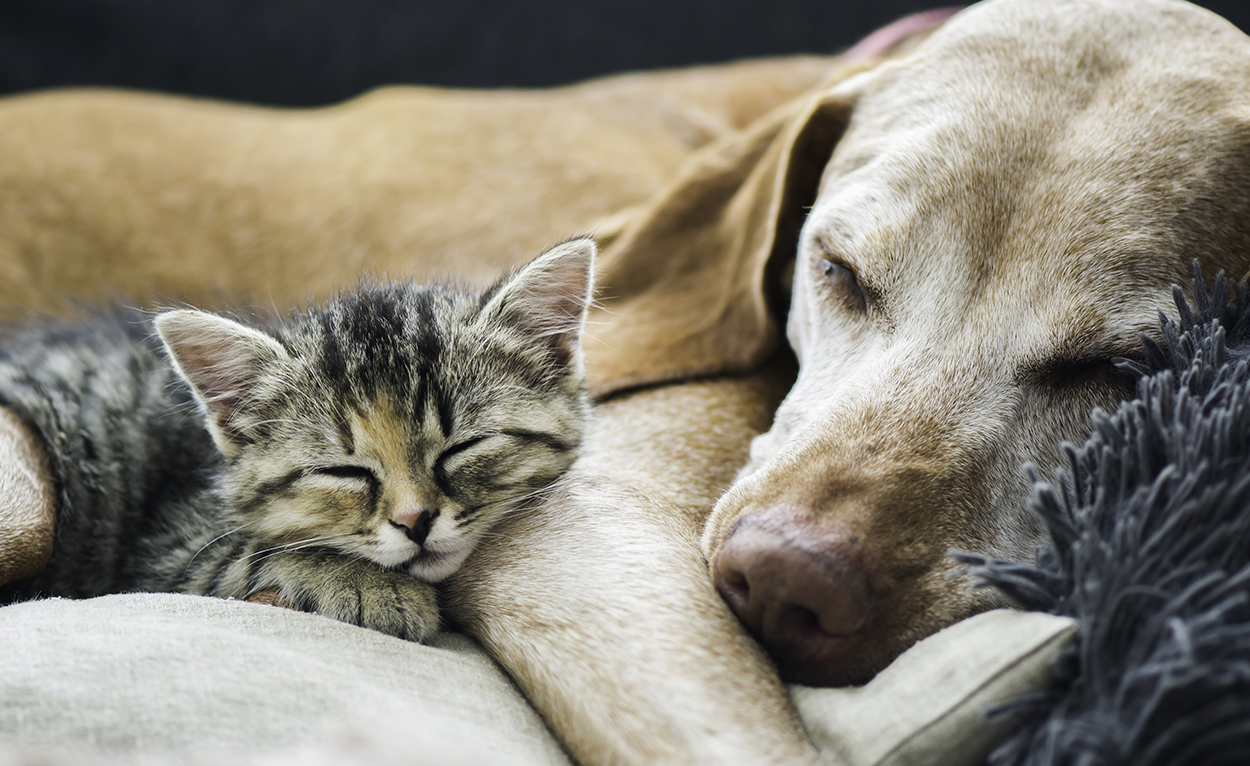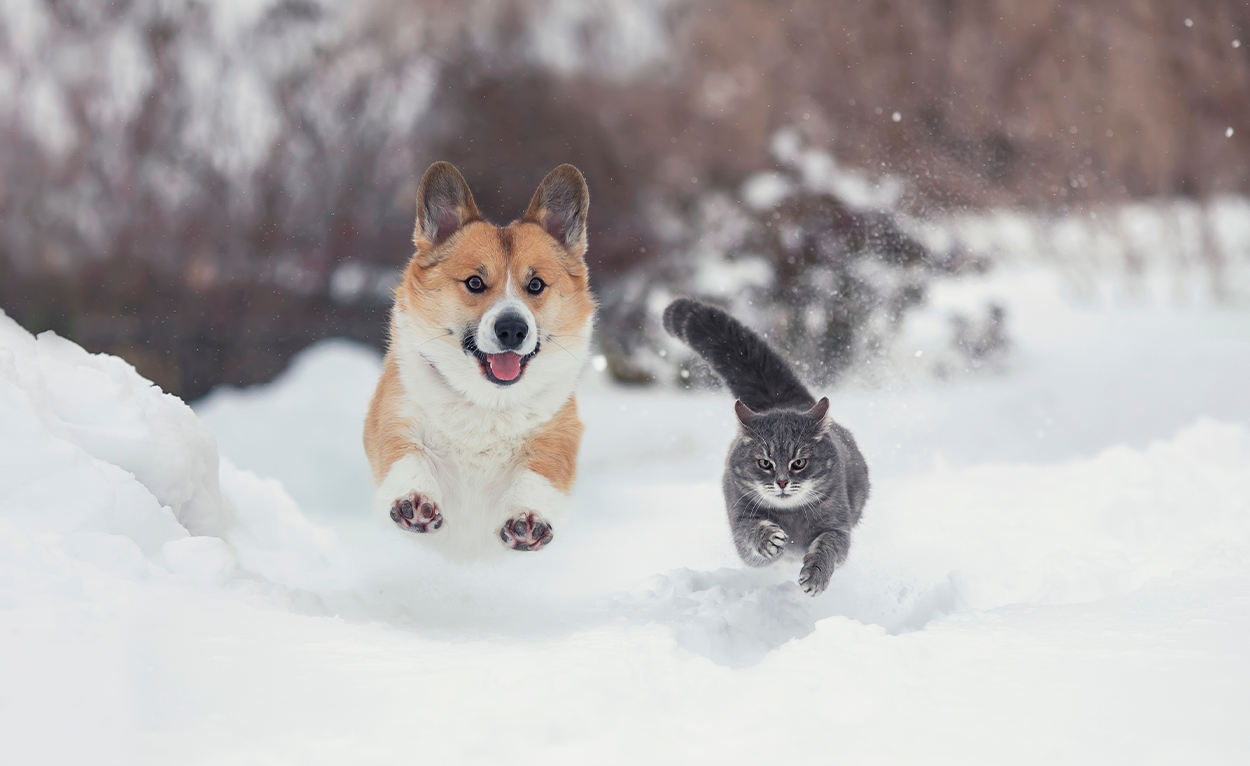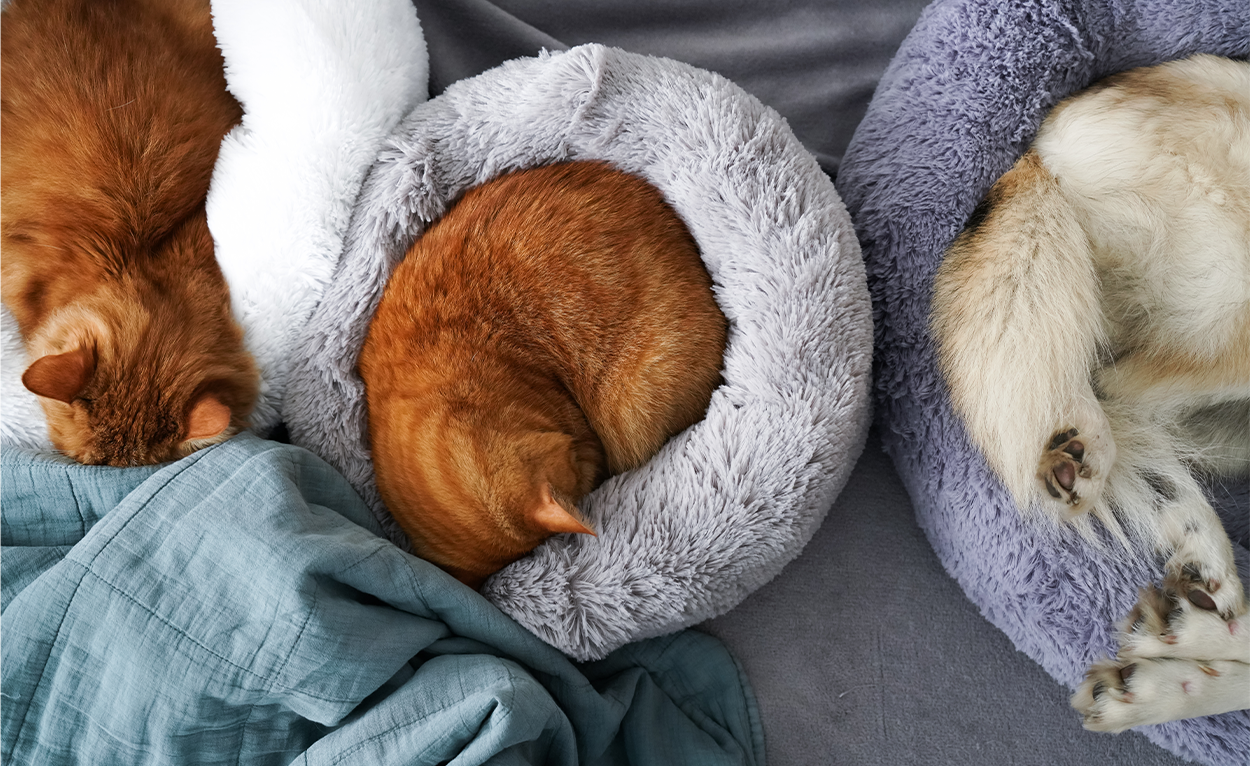24th November 2023
Keep your pet safe in the snow
Whether or not we were warned it was happening, snow can be a shock to our schedules!
The sudden change in our routines can be stressful for us, though it can also have an impact on our pets.
From worrying about wintry walks to wondering if it’s right to keep our cats indoors, it can be tricky to know what’s best for our pets when it snows. So, we’ve created this guide all about what to do with your pet during snowy weather, so you can make the most of snow-days, together.

What to do with your pet when it snows
Snow-days in the UK often lead to school closures, road closures, and working from home. While your pet is probably pleased that your whole family is home for the day, it may pose a problem when you’re trying to keep them calm yet entertained.
Should you walk your dog in the snow?
Whatever the weather, our canine companions still require exercise.
Luckily, there are ways to keep both of you safe in the snow:
- Protecting paws – using a specially-made protective paw balm, or petroleum jelly, on their paws before leaving for your walk adds a layer that may prevent damage to their paw pads. You can also purchase doggy boots which can provide protection and comfort, keeping your dog’s feet safe and warm in the cold.
- Short claws – although it’s important to keep your pooch’s claws short throughout the year, snowy conditions can increase the risk of damage to their nail beds. So, if you haven’t been able to make an appointment with your vet, or a qualified groomer, to get your dog’s claws clipped before snow hits, don’t panic! If your pet is willing, you may be able to gently file their claws down a little, using a normal nail file. The experts over at Joii Pet Care can give advice from the comfort of your own home, so please contact them if needed.
- Hi-vis accessories – both your safety and your dog’s safety should be top priority during snow-day walkies, and wearing high-visibility items can help car drivers and other road users see you. A hi-vis vest, worn over your coat, can help you to be seen, though your dog could wear a hi-vis harness, coat, or LED collar to improve their visibility. Check out our overview of high-vis dog products for more ideas!
- Keep them on a lead – although your pooch may prefer to bound around in that new, magical, white stuff, deep snow can hide hazards.
- Let someone know where you’re going – icy conditions can lead to slips, falls, and other accidents, which makes it even more important to carry a smartphone, in case you need to call for help. It’s also worth downloading the what3words app, which can assist people in finding you if there’s an emergency.
Please note: Snow can make familiar landscapes seem alien, especially to our dogs. We recommend getting a GPS tag for your best friend’s collar, and setting up the relevant app, to save you from getting separated in the snow.
Should your cat be allowed outside in the snow?
Our feline friends who love to frolic outside may disagree with the decision to keep them indoors when it snows. However, cats who are cold are more likely to crawl under car bonnets to keep warm, and it’s difficult for drivers to see cats in the snow.
Although keeping your cat indoors when it snows is the safest option, some of our feline friends hate being cooped up. If your cat can’t be kept indoors in bad weather, there are a few steps you can take to make wintry conditions safer for them:
- Create an outside shelter – have a cosy bed full of blankets set up in a sheltered place, like a shed or garage, so your pet can stay warm as temperatures drop. It’s also helpful to put a bowl of fresh, drinkable water in their outside shelter, and check it frequently, because your cat’s usual water source may be frozen.
- Install a cat flap – by adding a cat flap that allows them the option to stay inside or venture out into the snow, your feline friend will appreciate the freedom of choice. Every so often, you’ll need to check the cat flap still works if temperatures are icy.
- Cover potential hazards – places like ponds can be dangerous when it’s icy, so covering up hazards like ponds (and asking your neighbours to do the same!), will improve your cat’s safety outdoors.
- Keep them indoors at night – the best way to prevent dehydration and cold-related illnesses is to keep your feline friend indoors overnight.
- Check their microchip details – if you’ve moved recently, it’s important to keep your feline friend’s microchip details up to date, in case the snow confuses them, and they wander too far from home.
Aftercare of paws
Pets who step outside into snow will need their paws protected from future problems.

Caring for your dog’s paws after being out in the snow
Returning to a warm environment, after plunging their paws into the chilly snow, might cause your dog’s paw pads to crack and become sore if they’re left with damp paws. Wet paws can equal irritation and, in some cases, infection. To avoid this, you could carefully dry their paws as soon as they get home.
Another reason to gently wipe your dog’s paws, when they return from a wintry walk, is due to the risks of toxic rock salt used on roads and pavements. If your dog licks their paws after walking across surfaces gritted with rock salt, they’re in danger of being poisoned. You can also check for any cuts from the ice at the same time.
Long-term health problems that could be caused by ingesting rock salt from gritted roads and pavements include kidney damage, liver damage, and pancreatitis.
Here are some signs your dog may have ingested road grit or rock salt:
- Increased thirst.
- Dehydration.
- Vomiting.
- Diarrhoea.
- Lethargy (quieter than usual).
- Convulsions (fits).
Please contact your vet immediately if you think your dog has ingested grit or rock salt, even if they don’t appear to be showing any signs.
Caring for your cat’s paws after they’ve been out in the snow
It’s a mystery as to why some moggies prefer to play outside in bad weather, but if they do, there are dangers lurking beneath their paws.
Antifreeze is highly toxic to cats. Unfortunately, uncapped containers, spillages, and car fluid leakages heighten the risk of antifreeze poisoning. Additionally, the sweet taste of antifreeze can tempt cats into licking it off their paws (and fur). For kitties who can’t be kept indoors, it’s important to gently wipe their paws (and fur) every time they return from outdoor adventures.
Symptoms to suggest your cat might have swallowed something poisonous, like antifreeze, include:
- Inflamed, blistered, or swollen skin, paws, or mouth.
- Strange behaviour (e.g. shaking, staggering, off their food, etc.).
- Dribbling.
- Vomiting.
- Difficulty breathing.
- Collapse.
Even if they don’t display any of the above symptoms, if you think your cat has swallowed antifreeze, please contact your vet straight away.
Checking your feline friend’s paws whenever they return after spending time in the snow is important, too. While wiping your pet’s paws, it’s the ideal opportunity to check for irritation, as well as giving you chance to clear away any (potentially harmful) grit or debris.
Remember: Cat flaps can become blocked by heavy snow, so you’ll likely need to clear the area to allow your feline friend to get safely back inside.
What happens if your pet eats snow?
Snow consumption is dangerous to pets for several reasons, including:
- Hidden hazards – snow can contain toxic substances, like pesticides, rock salt, and antifreeze.
- Gastritis – if your mischief-maker manages to munch on some snow, they might suffer from an upset stomach and show signs of coughing, dribbling, diarrhoea, and vomiting.
- Lower body temperature – eating large quantities of snow could cause your pet’s body temperature to drop, which might put them at greater risk of health problems like hypothermia.
Ways to prevent your pet from eating snow:
- Keep dogs on a lead – it’s easier to stop your canine companion from eating snow if they’re on a lead.
- Keep cats indoors – if your feline friend is indoors, they’re not going to be able to eat snow.

Keeping your pet entertained on a snowy day
The weather outside may be frightful, though it doesn’t stop your pets from being excitable!
Finding ways to keep your best friend exercised and entertained while you’re all stuck indoors can be a bit of a challenge. Not to worry – there are plenty of ways to make snow-days more enjoyable for you and your pet…
Top tip: If you’re searching for a project to occupy your time on a snow-day, you could always get crafty and create a homemade pet toy!
Activities for dogs
Exercising their mind and body will help your pooch feel happier, instead of frustrated, about having to stay indoors. Here are some ideas for dog-friendly activities to enjoy while it’s snowing:
- Hide ‘n’ seek – whether it’s treats, toys, or pet parents, hiding something precious somewhere in the house and sending your pooch to find it can be brilliant fun for everyone!
- Puzzle toys – keep their mind ticking over by letting them try out a new puzzle toy. In case you haven’t had chance to buy a puzzle toy yet, there are loads of helpful videos on YouTube about making pet puzzle toys at home.
- Teach them a new trick – practise keeping them focused on you while teaching them a new trick. Don’t furget to reward your canine pal with praise and treats, for trying their best to listen and learn!
- Pet-friendly bubbles – you can now find boredom-busting bubbles specifically for dogs in pet shops and online. We recommend reading reviews before you choose pet-safe bubbles, and check that the bubbles won’t mark your furniture.
- Indoor agility course – make jumps out of cushions, tunnels out of hula hoops, and turn the stairs into an obstacle by placing a toy or treat at the top!
Activities for cats
They be more independent than their canine counterparts, but cats can have fun with pet parents during snow-days, too! Some ideas to help you and your feline friend make the most of extra time indoors this winter:
- Puzzle feeders – make your best friend work harder for their meal. Why not have a go at making your cat their own puzzle ball? All you’ll need is a cardboard inner tube of a toilet roll, a pair of scissors, and some cat treats!
- Create a cardboard cat gym – before putting cardboard boxes out to recycle, you could use them to make a special space for your cat to climb and hide in. If you have kids, get them involved by letting them decorate the boxes; that way, you’re keeping everyone entertained while it’s snowing outside!
- Prey games – chasing a piece of string or cat teaser toy around the house is an excellent way for them to exercise natural behaviours.
- Dinner dash – hide cat biscuits around the house, then send your cat to ‘hunt’ for their dinner.
- Teach them a trick or two – find the right reward for your feline friend, then have a go at teaching them a brand-new trick, or two.
Top tip: For more advice about entertaining your pet safely in the snow, the Joii Pet Care app is available 24/7 and is FREE for Animal Friends dog and cat policyholders!
Free vet video calls for your dog
24/7/365 with the Joii app.
Our partnership with Joii Pet Care gives Animal Friends policyholders free online veterinary help, whenever and wherever they need it. Download the Joii app today.
The vets and nurses at Joii can provide you with veterinary advice, preventative care and diet plans. Free and exclusive to Animal Friends customers. T&C's apply
Looking for more dog advice?
Find the information you need as we support you through every step of your journey with your canine companion.
Need dog insurance?
Dog insurance can help cover the cost of veterinary treatment if your dog gets injured or falls ill.
We know pets
Our pets are part of the family. To achieve our vision of a better future for pets everywhere, we work with our partners, vets, and other veterinary professionals who are pioneering the latest advancements in animal care. Our campaigns, articles, and events are crafted to support, educate, and celebrate pet owners, while our policies are designed to provide peace of mind at an affordable price.
Yet our policies don’t just protect against the unexpected – they have purpose, too.
Since we were founded over 25 years ago, we've provided industry-leading policies that protect the nation’s pets, while also making a difference to animal welfare and our planet. Thanks to you, our policyholders, we've donated over £9 million to more than 830 animal welfare charities and conservancies, helping to support vulnerable pets and wildlife around the world.
We’re proud to be wildly different. Are you?
